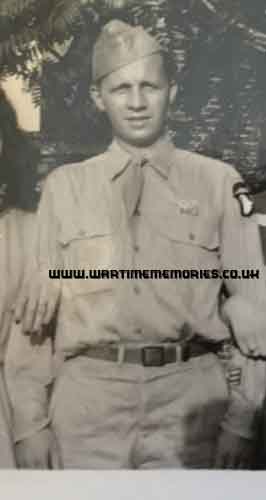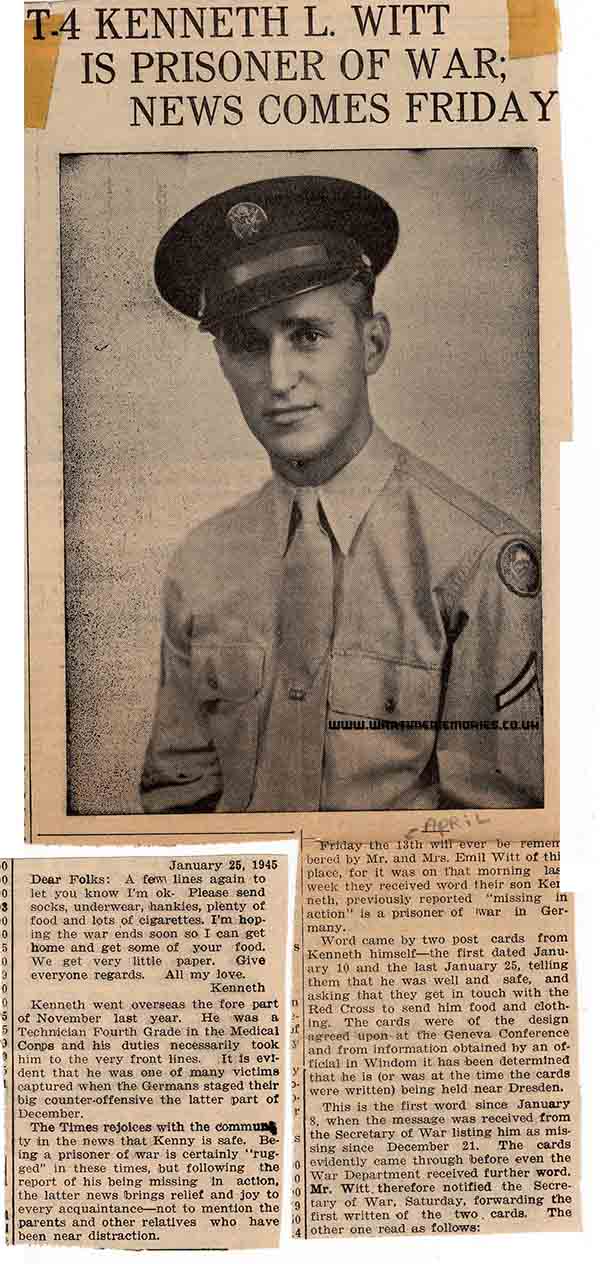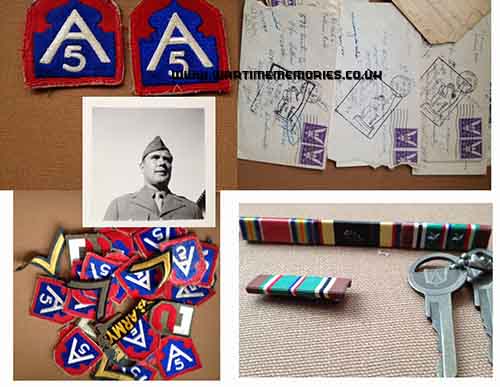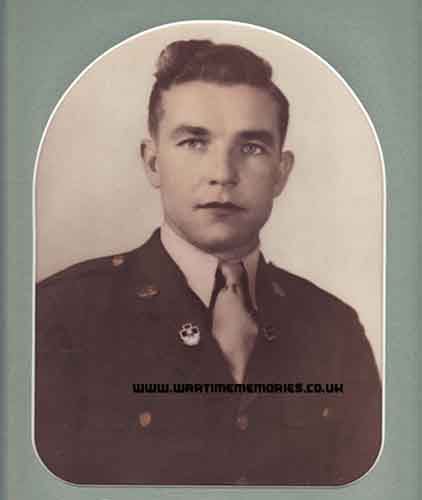|
|
|
US Army Medical Corps
If you can provide any additional information, especially on actions and locations at specific dates, please add it here.
|
|
|
The Wartime Memories Project is the original WW1 and WW2 commemoration website.
Announcements

- 1st of September 2024 marks 25 years since the launch of the Wartime Memories Project. Thanks to everyone who has supported us over this time.
- The Wartime Memories Project has been running for 25 years. If you would like to support us, a donation, no matter how small, would be much appreciated, annually we need to raise enough funds to pay for our web hosting and admin or this site will vanish from the web.
- 26th Mar 2025 - Please note we currently have a huge backlog of submitted material, our volunteers are working through this as quickly as possible and all names, stories and photos will be added to the site. If you have already submitted a story to the site and your UID reference number is higher than
265607 your information is still in the queue, please do not resubmit, we are working through them as quickly as possible.
- Looking for help with Family History Research?
Please read our Family History FAQs
- The free to access section of The Wartime Memories Project website is run by volunteers and funded by donations from our visitors. If the information here has been helpful or you have enjoyed reaching the stories please conside making a donation, no matter how small, would be much appreciated, annually we need to raise enough funds to pay for our web hosting or this site will vanish from the web.
If you enjoy this site
please consider making a donation.
Want to find out more about your relative's service? Want to know what life was like during the War? Our
Library contains an ever growing number diary entries, personal letters and other documents, most transcribed into plain text. |
|
Wanted: Digital copies of Group photographs, Scrapbooks, Autograph books, photo albums, newspaper clippings, letters, postcards and ephemera relating to WW2. We would like to obtain digital copies of any documents or photographs relating to WW2 you may have at home. If you have any unwanted
photographs, documents or items from the First or Second World War, please do not destroy them.
The Wartime Memories Project will give them a good home and ensure that they are used for educational purposes. Please get in touch for the postal address, do not sent them to our PO Box as packages are not accepted.
World War 1 One ww1 wwII second 1939 1945 battalion
Did you know? We also have a section on The Great War. and a
Timecapsule to preserve stories from other conflicts for future generations.
|
|
Want to know more about US Army Medical Corps? There are:0 items tagged US Army Medical Corps available in our Library There are:0 items tagged US Army Medical Corps available in our Library 
These include information on officers, regimental histories, letters, diary entries, personal accounts and information about actions during the Second World War. |
|
Pte. Archie A. Vincitore 193rd General Hospital My father's army records were lost in a fire in archives. He died 1993. I know he came to Scotland on the Queen Mary around October, 1943. His unit was 193rd General Hospital. His unit was sent to Verdun, France.
|
Gasper Lombardo Army Medical Corps My great-uncle, Gasper Lombardo, served in the US Army Medical Corps and was stationed in Cairo during WWII. I believe his unit worked with British counterparts would like to find out more information about collaboration between US and British medical corps in Cairo at this time for background research to my own geneology study I am doing. Can anyone help?
|
2nd Lt. Rosemarie Nixon Medical Corps Rosemarie Nixon was an Army nurse in the China-Burma-India Theater in World War II, she treated the wounded soldiers of the legendary Merrill's Marauders in World War II. A trained nurse, she enlisted in the Army in May 1941, and served until December 1945. She was on her way to India when the Japanese bombed Pearl Harbor. She took it on herself to write letters home for soldiers who had lost the use of their hands.
Rosemarie, who attained the rank of second lieutenant, became disabled after a concussion caused by explosives and was treated at the Valley Forge Military Hospital when she returned to the U.S.
|
Capt. Dorothy Hillenbrand 40th Field Hospital Sister Dorothy Hillenbrand was a U.S. Army nurse, who served as an active-duty nurse in the 40th Field Hospital attached to the Ninth Air Force.
Three days after the D-Day invasion, she landed at Normandy. Over the next two years, she served in England, France, Belgium, and Germany. She was honorably discharged in January 1946 with the rank of captain. "She didn't talk much about what she had seen," said a colleague. But those who knew her said Sister Dorothy worked at a hospital, tending the wounded straight from the battlefield. She was known as a caring, compassionate nurse. But she brooked no nonsense from underlings who didn't follow directions.
|
1st Lt. Medic Theodore Tobias Bronk Medical Corps POW Camp Fukuoka 17 in Japan. Camp Doctor.
Mentioned in Whitecross's excellent book, "Slaves of the Son of Heaven". Published in 1951, the book mentions many names and incidents from Camp 17.
|
Pfc. Edwin James Butler Medical Detachment, Corregidor (d.7 February 1945) Died in POW Camp Fukuoka 17 in Japan and was a Survivor of the Hell Ship the Oryoku Maru.
|
Pvt. Raymond Gonzales Carrizales Sternberg General Hospital, Manila. Medical Corps Raymond Gonzales Callizales, Private (Medic.)18043889, US Army Medical Corps. Unit served at was the Medical Department, Sternberg General Hospital, Manila, Phillipines. He was captured and survived the Oryoku Maru Hell Ship following which he was interned at the POW Camp Fukuoka 17 in Japan.
|
Sgt. Kenneth Leroy Witt 106th Infantry My Dad, Ken Witt served in the US Army. He was a medic and was one of the green soldiers shipped over to near Belgium in December of 1944. Captured in the Battle of the Bulge. They were marched and sent by train to Stalag IVB. He was listed MIA for over a month until his parents received word he was a Prisoner of War. Liberated by the Russian Army in April 1945. He received a Purple Heart for frozen feet. His weight while a POW went from about 150lb down to near 90lb when liberated. Kenny passed away in 1978.
From the reports it seems he was 4th Grade Technician serving in the Medical Corps.
|
Pvt. Robert William Champaigne 326th Med Company 101st Airborne My grandfather, Pvt Robert W. Champaigne 101st Airborne, 326th Medical Airborne Company, was captured Dec. 19th, 1944 near Bastogne, Belgium during the Battle of the Bulge. He was a POW at Stalag 4B Muhlberg Sachen 51 13 from 19 Dec. 1944 to 9 Jun. 1945.
|
Pte. Kenneth Moore Medical Corps  In the middle of one of World War II's bloodiest battles — the 1944 D-Day invasion of western Europe — there was a small sanctuary where no fighting was permitted.
Inside a village church in France, two Army medics — Ken Moore and Bob Wright — cared for dozens of wounded soldiers, using the pews as makeshift beds. Mortar blasts rocked the building, but the medics refused to leave, even when told enemy forces were about to overrun the village.
With scant supplies, they stayed on to administer aid in the packed church, and not just to Americans. They also treated wounded German soldiers who came to the door seeking help.
"They were young men much like us, except they were wearing a different uniform." Moore said in the documentary "Eagles of Mercy,"
The stone church, located in the village of Angoville-au-Plain, commemorates the medics' actions with a monument on the edge of an adjoining cemetery.
Moore said in the 2013 public television documentary that he was astonished "Bob and I, just a couple of privates in the service, received such honors". But Daniel Hamchin, the village mayor, said their role pointed out the dichotomy of that day for soldiers.
"They would kill each other in the cemetery," Hamchin said, "and they would heal each other in the church."
Moore volunteered to be a paratrooper and was chosen to be a medic, although he got only about two weeks of medical training.
He didn't see any combat until D-Day, June 6, 1944, when he was one of thousands of troops parachuted into France. As a medic, he carried medical supplies, but no weapon.
Hitting the ground, he was quickly under fire. "There's no substitute for hearing a bullet snap past your head, and you realize that someone is trying to kill you," he said in the film. "You can't explain or put into words how that feels, but it forever changes you."
He and Wright commandeered the 12th century church, designating it as an aid station by hanging a Red Cross banner outside. Wright had more medical training than Moore, but their expertise was limited.
"Our training and our job essentially was to stop the bleeding," Moore said in the film, "and administer morphine for pain and bandage up the casualties as best we could."
Wright instituted an order that all rifles had to be left outside the door and the injured began streaming in, by themselves or with the help of others. As the wooden pews started to fill, the medics designated an area near the alter for critically injured soldiers they couldn't much help.
With Wright taking on the bulk of medical duties, Moore sometimes ventured outside to haul injured soldiers to the church in a cart found nearby. This time, with his Red Cross arm band in full view, he didn't take fire.
"The Germans were pretty good about not shooting at medics," he said. "There were several times they could have shot me, and they didn't."
At times, the battle raged so close that the building shook violently, blowing out the windows. A mortar shell that came through the roof didn't explode, but when a chunk of the ceiling came down, it smacked Moore in the head, causing him to bleed. "That's when I got my Purple Heart," he said. "I was embarrassed to take it."
According to the Geneva Convention treaty, signed by the U.S. in 1882, soldiers wounded in battle were to receive aid by medics regardless of which side they were on. The rule was strictly applied inside the church, with Germans getting aid alongside Americans. "I don't recall any real animosity being expressed," Moore said.
U.S. soldiers rushed in at one point to say they couldn't hold the town and they recommended that at least one of the medics fall back with them. But by then, the church was so packed with wounded that blood was leaking onto the floor as well as the pews. "Bob and I looked at each other," Moore said, "and said, 'We better both stay.'"
Tense moments followed as the enemy took the area and German soldiers with machine guns came into the church. But seeing Germans and Americans both being treated, they left without incident.
The situation eased and eventually the aid station was dismantled. In all, Moore and Wright treated more than 80 soldiers, including about a dozen Germans. They were awarded Silver Star medals for their actions, and both served in other battles, including the Battle of the Bulge.
He occasionally returned to Angoville-au-Plain, where bloodstains can still be seen in the church pews, for ceremonies commemorating his and Wright's actions on D-Day
"I think the reason it's gotten attention now is that we weren't involved in killing, we weren't trigger pullers," he said in the film. "I tell my grandchildren that my role in the war was sort of as an observer. I wasn't a rifleman killing people, and I was there in one of the big historical events of our century."
|
PFC. Arthur Fredrick Soderberg 576th Ambulance Company Medcial Corps Art Soderberg didn't speak much of his experience, but we have letters stating that these soldiers were not to speak of it. Arthur was a strong man who endured 9 months in Stalag 7A. We have a book which documented some of his friends (we think) with names and addresses marked on it (very small pocket size probably to hide from the Germans). We have an application for living ex prisoner of war compensation for compulsory labor and or inhumane treatment. Arthur never filled this out. I imagine there was nothing to compensate such atrocities endured. I spoke with his brother who indicated that men in this camp were routinely pistol whipped and fed saw-dust mixed with potatoes, these were the only things mentioned, along with trading Lucky Strikes for bread. Arthur was allowed to bring home the German decorative swords granted by Cornel Eisenhower.
|
Pvt. Edison James Bunion "Sonny" Smith 111th Medical Regiment 36th Division Edison Smith served with the 111th Medical Regiment in 36th Division
|
Pte. William Troy Paine 326th Medical Corps  My father, William Troy Paine (Bill), served in the US Army from 1943 to 1945. He was a medic with the 326th Medical Corps, 101st Airborne Division. He participated in "Market Garden" and landed in Zon. He worked for months at the regimental hospital near the Wilhelmina Canal and was later captured at the "Battle of the Bulge" in Bastogne, Belgium on December 19, 1944. He, along with other prisoners, marched in the snow for days and was packed into railroad cars where they could only stand. He was taken to Stalag IV-B. His POW dogtag No. 316777. He remained there until he was liberated by the Russians.
He did not speak of his experience in the camp often, but he did recall the body lice, hepatitis, and the weight loss. Throughout his life, whenever it snowed my father broke out in a neurogenic rash.
There was one person who he spoke of in the whole camp. This was an Asian American in his barracks. The reason he remembered this man is because he would walk up and down the barracks and say "There are three great men in this world.... Roosevelt... Churchill... and Me (the prisoner stated his name)!"
The closest he came to getting killed in WWII was while he was on a work detail to gather wood. The American planes accidentally strafed the prisoners, killing many. The next day the American planes dropped a wreath over the camp.
Upon liberation by the Russians, he and two other prisoners escaped the Russians. They had to steal cheese from the basement of a German home to survive the trek from the camp to the American lines across the Elbe River.
My father died in July 2010. I know little about his time in Stalag IV-B
If anyone has any more information on that or his trek to the Elbe please contact me.
|
Carl F. McDaniel 279th Station Hospital Medical Corps I was with the 279th Station Hospital in Wales near Abergavenny for one and a half years. I took care of the wounded on D-Day and after, and then went to France and finally to Berlin.
|
PFC. John Henry "Corky" Capozzoli Medical Corps I loved my father, John Capozzoli, with all of my heart. He was a family man as well as a solider dedicated to his country. He loved his country and to help others in need. Up until his passing in 2001, he volunteered and dedicated his time to terminally ill patients at St. Mary's Hospital located in Bucks County, PA until he was diagnosed with bone marrow cancer. Strong, caring, a devoted family man, husband, father, grandfather and great-grandfather.
Dad, I love you and you're always in my heart, mind and soul. Wish you would have met my crazy wife, your daughter-in-law, Michelle.
|
1st Lt. Edwin W. Tucker 12th Medical Regiment Medical Corps After completing my tour of duty with the US Army in Germany in May 1975, I had the honor and pleasure of serving under Dr. Tucker from late 1975 to mid-1977, when I was working as a civilian counselor with the US Army's 5th General Hospital Drug and Alcohol Service in Bad Cannstatt, Germany. Dr. Tucker (also a civilian, but who was a WW2 veteran) was the Chief of Service and a well-known and highly regarded authority in the field of substance abuse treatment.
During one of our many conversations, I recall his telling me that he was serving as a young US Army doctor in the Philippines when the Japanese invaded in December 1941. He was taken prisoner at the surrender of US forces there in early April 1942, survived the infamous Bataan Death March to Camp O'Donnell, and was then transferred to the Hakodate POW Camp-Babai on Hokkaido Island, where he was held for the rest of the war.
|
Recomended Reading.Available at discounted prices.
|
|
|









